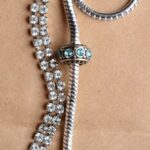What is the difference between high and fine jewelry? In the world of luxury accessories, this distinction holds significant importance for both consumers and enthusiasts. Understanding the characteristics, materials, craftsmanship, and value differences between high and fine jewelry can greatly impact one’s appreciation and investment in these exquisite pieces. This article aims to provide a comprehensive insight into the disparity between high and fine jewelry, shedding light on their unique qualities and appeal.
High jewellery is a category revered for its exceptional quality, rarity, and craftsmanship. These pieces are often created using the finest materials such as diamonds, gemstones, and precious metals, with meticulous attention to detail in every aspect of their construction. On the other hand, fine jewelry also boasts superior craftsmanship and use of quality materials but may not necessarily reach the same level of rarity or exclusivity as high jewelry.
When it comes to luxury accessories like jewelry, the distinction between high and fine pieces often lies in their design intricacy as well as pricing. While both categories exude a sense of opulence and elegance through their intricate designs and impeccable craftsmanship, high jewelry tends to command a higher price due to its exclusivity and rareness. Understanding these differences can greatly impact discerning consumers’ purchasing decisions and perceptions of value within the world of luxury accessories.
Defining High Jewelry
High jewelry is a category of luxury accessories that is characterized by its exceptional quality, craftsmanship, and exclusivity. What sets high jewelry apart from other categories, such as costume or fashion jewelry, is the use of the finest materials and the intricate designs that require exceptional skill and artistry to create. High jewelry pieces are often one-of-a-kind or produced in limited quantities, adding to their allure and value.
One of the key differences between high jewelry and other categories is the use of precious gemstones and metals. High jewelry pieces often feature rare and valuable gemstones such as diamonds, rubies, sapphires, and emeralds, which are set in platinum or high-karat gold. These materials not only contribute to the intrinsic value of high jewelry but also reflect the unparalleled beauty and luxury associated with these pieces.
In addition to the materials used, the craftsmanship involved in creating high jewelry sets it apart from fine or fashion jewelry. Each high jewelry piece is meticulously handcrafted by highly skilled artisans who pay meticulous attention to detail.
The complexity of designs in high jewelry often involves intricate settings, elaborate motifs, and innovative techniques that showcase the pinnacle of craftsmanship. This level of artistry is what distinguishes high jewelry from other categories and contributes to its reputation as a collector’s item for connoisseurs of luxury accessories.
| Category | Distinguishing Characteristics |
|---|---|
| High Jewelry | Exceptional quality, craftsmanship, exclusive use of precious gemstones and metals |
| Fine Jewelry | Precious metals like gold or platinum paired with natural gemstones; more accessible pricing compared to high jewellery |
Characteristics of Fine Jewelry
Fine jewelry is a category of luxury accessories that holds its own distinct characteristics and qualities, setting it apart from other types of jewelry. Unlike costume jewelry or fashion jewelry, fine jewelry is crafted with precious metals and gemstones, making it a valuable investment for the wearer. The distinction between high and fine jewelry lies in the craftsmanship, materials used, design elements, and overall value.
Materials Used
One of the defining characteristics of fine jewelry is the use of high-quality materials such as gold, platinum, and sterling silver. These precious metals are known for their durability and timeless appeal, adding to the longevity and value of fine jewelry pieces. In addition to metals, fine jewelry often features gemstones such as diamonds, sapphires, rubies, and emeralds. These stones are selected for their clarity, color, and carat weight, further enhancing the value of the piece.
Design and Craftsmanship
Fine jewelry is renowned for its intricate designs and impeccable craftsmanship. Each piece is carefully handcrafted by skilled artisans who pay meticulous attention to detail. The emphasis on precision and quality in both design and production contributes to the overall uniqueness of fine jewelry pieces. From delicate filigree work to elaborate settings for gemstones, fine jewelry showcases exceptional artistry that sets it apart from mass-produced accessories.
Price and Value
The value of fine jewelry extends beyond its aesthetic appeal to encompass its monetary worth as well. Due to the use of precious metals and gemstones along with superior craftsmanship, fine jewelry commands a higher price point compared to fashion or costume jewelry.
Furthermore,it holds its value over time makes it a worthy investment for discerning buyers seeking quality pieces that can be cherished for generations. This aspect differentiates it from high fashion or trendy pieces that may lose their allure as trends come and go.
Understanding these defining characteristics can help consumers make informed choices when purchasing luxury accessories like high or fine Jewelry.Therefore It is important to acknowledge what separates them especially if you need Return on investment (ROI) in your jewellery choices.
Materials Used
High and fine jewelry are both categories of luxury accessories that are known for their exquisite materials and exceptional craftsmanship. The materials used in these pieces play a crucial role in defining their value, quality, and overall appeal. Whether it’s high-end diamonds or precious gemstones, the choice of materials sets high and fine jewelry apart from other categories in the market.
Below are some of the materials commonly used in both high and fine jewelry:
- Precious Gemstones: High-quality diamonds, emeralds, rubies, and sapphires are often featured prominently in both high and fine jewelry pieces. These gemstones are valued for their rarity, brilliance, and color intensity, making them highly sought after by discerning collectors and enthusiasts.
- Precious Metals: Gold (in various colors such as yellow, white, and rose) and platinum are the metals of choice for crafting high and fine jewelry. These metals not only provide durability but also add a luxurious touch to the overall design.
- Rare Pearls: Cultured or natural pearls are another prized material used in luxury jewelry pieces. Their luster and uniqueness contribute to the elegance of high and fine jewelry designs.
These materials contribute significantly to the overall value of high and fine jewelry pieces. The rarity, purity, clarity, and carat weight of these materials are carefully assessed to determine their worth in the market. Additionally, the quality of these materials is a key factor that distinguishes high and fine jewelry from other accessory categories. The use of such premium materials elevates these pieces to an elite status within the luxury sector.
Ultimately, understanding the significance of these materials is essential for anyone interested in investing in high or fine jewelry. It allows consumers to make informed decisions when purchasing these exquisite pieces while also appreciating the artistry behind their creation.
Design and Craftsmanship
On the other hand, fine jewelry also places a strong emphasis on design and craftsmanship, albeit with some differences from high jewelry. Fine jewelry pieces are typically more accessible than high jewelry but still embody superior quality and attention to detail.
While they may not boast the same level of rarity or exclusivity as high jewelry, fine jewelry items are expertly crafted using premium materials such as 18-karat gold, sterling silver, diamonds, and other precious gemstones. The designs of fine jewelry pieces are often timeless and versatile, catering to a broader range of styles and preferences while maintaining a sense of sophistication.
Distinctive Features of Craftsmanship
In both high and fine jewelry, the level of craftsmanship is unparalleled compared to mass-produced accessories. Each piece undergoes meticulous hand-finishing by skilled artisans who have honed their craft over years or even generations. These craftsmen pay close attention to every intricate detail, ensuring that each element – from the setting of gemstones to the polishing of metal – meets the highest standards of precision and perfection.
Innovation vs Timelessness
One distinguishing factor between high and fine jewelry design is the approach to innovation versus timelessness. In high jewelry, designers often push creative boundaries by experimenting with unconventional materials or avant-garde concepts to produce statement-making pieces that defy convention. Fine jewelry, on the other hand, focuses on timeless elegance and classic designs that endure changing trends. The emphasis is on creating pieces that can be cherished for a lifetime rather than following fleeting fashion fads.
Whether it’s the groundbreaking designs of high jewelry or the enduring appeal of fine jewelry craftsmanship-they both represent exceptional artistry that elevates them above mass-produced accessories.
Price and Value
When it comes to understanding the difference between high and fine jewelry, one of the most important aspects to consider is the pricing and value of these luxury accessories. The distinction between the two lies not only in their cost but also in the factors that contribute to their perceived value. High jewelry is known for its exorbitant prices, often reaching into the millions of dollars for a single piece.
This category of jewelry is characterized by its use of rare and exceptional gemstones, such as diamonds, sapphires, rubies, and emeralds. The craftsmanship involved in creating high jewelry pieces is unparalleled, with expert artisans meticulously crafting each piece by hand.
On the other hand, fine jewelry also commands a significant price but is generally more accessible than high jewelry due to its use of semi-precious gemstones and other high-quality materials. While fine jewelry may not reach the same astronomical prices as high jewelry, it still retains its value as a long-term investment. The intricate designs and superior craftsmanship associated with fine jewelry contribute to its desirability and enduring worth.
The pricing and value differences between high and fine jewelry are influenced by various factors, including the rarity of materials used, the reputation of the jeweler, and the level of craftsmanship involved in creating each piece. Additionally, branding plays a crucial role in determining the perceived value of both high and fine jewelry.
Consumers are often willing to pay a premium for items associated with renowned luxury brands due to their established reputations for quality and exclusivity. Understanding these pricing and value differences is essential for discerning consumers who seek to make informed decisions when investing in luxury jewelry pieces.
| Pricing Factors | High Jewelry | Fine Jewelry |
|---|---|---|
| Rarity of Materials | Exceptionally rare gemstones | Semi-precious gemstones |
| Craftsmanship | Impeccable craftsmanship by expert artisans | Superior craftsmanship with attention to detail |
| Reputation/Branding Premium | Significant premium due to association with top-tier luxury brands | Premium associated with reputable jewelers but less pronounced than high jewelry |
Branding and Reputation
When it comes to the world of luxury accessories, the reputation and branding of a jewelry house can significantly impact how their pieces are categorized. This is especially true when distinguishing between high and fine jewelry. The reputation of a jewelry house often sets the tone for the categorization of its pieces, influencing consumer perceptions and market positioning.
One key factor that distinguishes high jewelry from fine jewelry is the brand behind the pieces. High jewelry is often associated with prestigious and renowned jewelry houses that have a long-standing heritage in creating exquisite and exceptional pieces.
These brands are synonymous with luxury, exclusivity, and exceptional craftsmanship. On the other hand, fine jewelry may be created by both well-known jewelry houses as well as emerging designers, offering a wider range of styles and designs to cater to different consumer preferences.
The reputation of a jewelry house also plays a significant role in determining whether its pieces are categorized as high or fine jewelry. High jewelry is often associated with iconic and legendary brands that have established themselves as leaders in the industry.
The exclusivity and rarity of high jewelry pieces are often enhanced by the reputation of the brand, adding to their allure and value. Fine jewelry, while still maintaining a level of prestige, may encompass a broader range of brands that cater to different segments of the market.
- High Jewelry
- Fine Jewelry
- Brand Reputation
- Market Positioning
- Luxury Accessories
Demographics and Target Audience
When it comes to understanding the difference between high and fine jewelry, it is essential to consider the demographic and target audience for each category. High jewelry is often targeted towards ultra-high-net-worth individuals who are looking for exclusive, one-of-a-kind pieces that exude opulence and luxury.
These individuals are usually collectors or connoisseurs of fine jewelry, seeking unique designs and rare gemstones that hold significant value. They are willing to invest a substantial amount of money in pieces that are not only beautiful but also hold historical or cultural significance.
On the other hand, fine jewelry tends to cater to a slightly broader demographic, including affluent individuals who appreciate quality craftsmanship and timeless designs. This category appeals to those who want to invest in pieces that can be worn daily or on special occasions, providing both elegance and versatility. Fine jewelry also attracts consumers who are looking for more accessible luxury options, offering a balance between quality and affordability.
Understanding the demographics and target audience for high and fine jewelry is crucial for both consumers and brands. For consumers, it allows them to make informed decisions when investing in luxury accessories that align with their personal preferences and lifestyle.
For brands, recognizing their target market helps them create marketing strategies and product offerings that resonate with their ideal clientele. In essence, the difference in target audiences underscores how high and fine jewelry serve distinct purposes within the realm of luxury accessories.
Furthermore, the distinction in target demographics influences where these categories are marketed and sold. High jewelry is typically showcased in exclusive boutiques or exhibited at prestigious events catering to elite clientele. Fine jewelry, on the other hand, may be available through a wider range of retail outlets, including upscale department stores or dedicated jewelers targeting affluent consumers seeking quality pieces without entering high-end watch shops exclusively.<
Conclusion
In conclusion, the distinction between high and fine jewelry is based on various factors including materials used, design and craftsmanship, price and value, branding and reputation, and the target consumer demographic. Understanding these differences is crucial for anyone looking to invest in luxury accessories or simply appreciate the artistry behind these pieces.
The key difference between high and fine jewelry lies in their value, quality, and exclusivity. High jewelry typically uses rare and precious gemstones like diamonds, sapphires, emeralds, and rubies, while fine jewelry may use semi-precious stones like amethysts, garnets, or aquamarines. Additionally, high jewelry is often one-of-a-kind pieces created by renowned designers with exceptional craftsmanship. On the other hand, fine jewelry may feature more accessible designs produced by both luxury brands and independent artisans.
Understanding the difference between high and fine jewelry not only allows consumers to make informed purchasing decisions but also helps them appreciate the artistry and heritage behind these pieces. Whether it’s the exquisite craftsmanship of a high jewelry piece or the timeless elegance of a fine jewelry item, each category offers something unique for those with a passion for luxurious adornments.
Frequently Asked Questions
What Is Considered as Fine Jewelry?
Fine jewelry is typically made with high-quality materials such as precious metals like gold, silver, or platinum, and adorned with gemstones like diamonds, rubies, sapphires, and emeralds. It is often crafted with intricate designs and superior craftsmanship, resulting in pieces that are considered valuable and luxurious.
What Is a High Quality Jewelry?
High quality jewelry is characterized by the use of durable and long-lasting materials such as solid gold or platinum, high-grade sterling silver, and genuine gemstones that are carefully selected for their clarity, color, and cut. Additionally, high quality jewelry often exhibits superior workmanship and attention to detail in its design and construction.
What Are the Different Levels of Jewelry?
Jewelry can be categorized into different levels based on the materials used, craftsmanship involved, and overall value. At the lower end of the spectrum are costume jewelry or fashion jewelry made with non-precious metals and synthetic stones. Mid-range options include semi-precious gemstones set in sterling silver or gold-plated settings.
At the highest level is fine jewelry made with precious metals like 18k gold or platinum set with genuine diamonds and other precious gems. Each level represents a different standard of quality and value within the realm of jewelry.

Welcome to my jewelry blog! My name is Sarah and I am the owner of this blog.
I love making jewelry and sharing my creations with others.
So whether you’re someone who loves wearing jewelry yourself or simply enjoys learning about it, be sure to check out my blog for insightful posts on everything related to this exciting topic!





